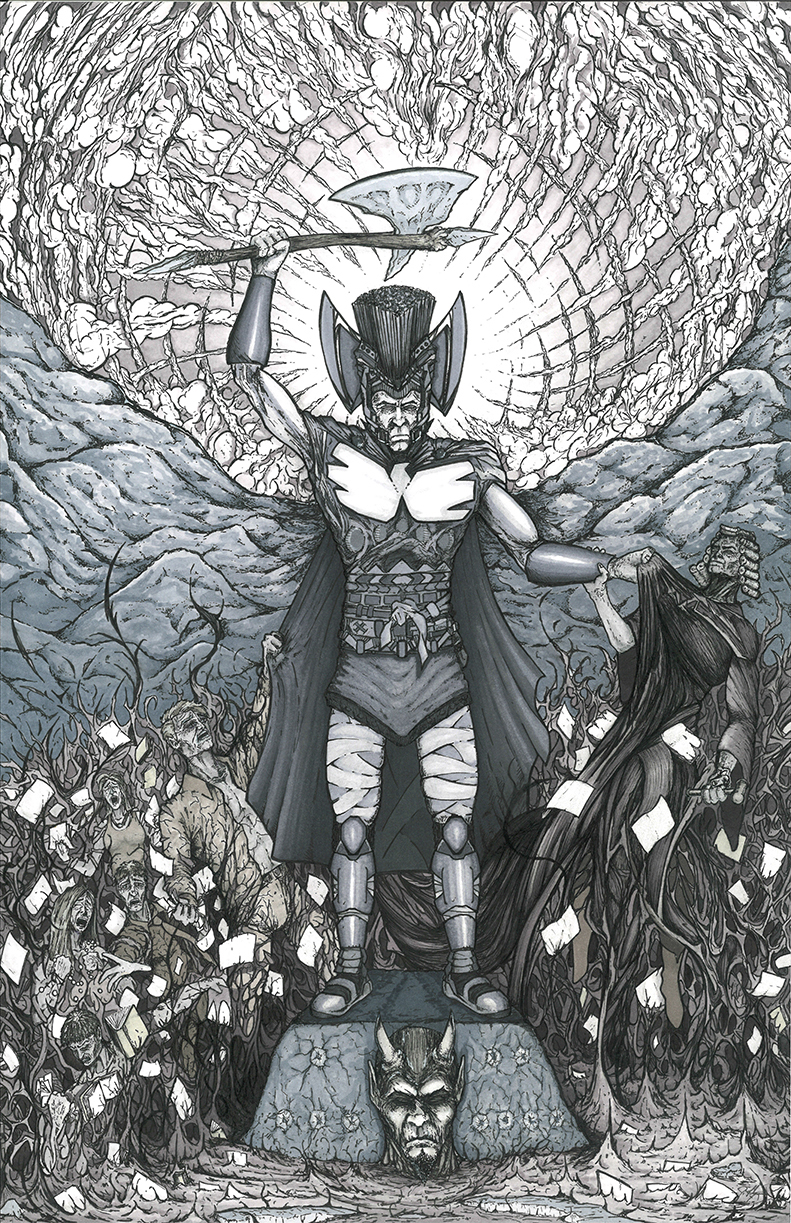
Ideas: This grey-scaled commission was an epic journey, a quest through a plague ravaged world. The piece is for a grade school friend and inspired by the timeless writing on Toltec philosophy, The Four Agreements by Don Miguel Ruiz. The Four Agreements are as follows: 1) Be impeccable with your word. 2) Don’t take anything personally. 3) Don’t make assumptions. 4)Always do your best. These simple promises to oneself can profoundly adjust the way one interacts with the world, there is a universal applicability. The Toltecs (900–1168 CE) were predecessors to the Aztec and Mayan empires in Pre-Colombian Mesoamerica. Upon reading the book, he was moved by a particular passage that described overcoming the suffering induced by the symbolic “Parasite”, and its three principal representatives: Victimization, Judgment, and Belief Systems. My goal was to illustrate the Toltec Warrior triumphant over these oppressive psychological forces. I didn’t realize I would need to relive every lesson of the book to complete this drawing. I love these literary commissions, they provide an opportunity to revisit old stories and wisdom with fresh eyes. It is definitely one of my most complex pieces to date, and was nearly impossible to finish. Like the warrior, I was determined and I was able to overcome. The main figure of the Toltec warrior stands very tall. He was inspired by the giant stone Atlantean sculptures of the Toltecs found in Tula, an archaeological site southwest of Hildago, Mexico. He stands elevated on a flattened stone with Aztec markings for numerals 1-4 chiseled into it’s face. Directly below his feet we find the decapitated head of the defeated “Parasite”. His blood crashes out to each side in waves and the symbolic concepts of suffering rise from the collecting pools. On the left of the composition, figures of victimization struggle and claw at the stoic warrior. They try without success to pull him down, for they are powerless in the presence of the statuesque figure. They are also only victims in their own minds, not legitimate victims of suffering through no fault of their own. This is illustrated by idealized looks, clutching of pearls, and desperately grasping at the documents floating up out of the undulating blood. These are the representation of the belief systems, and are surrounding both of the rising symbols. The victimized are enveloped by it, boundlessly tethered to the promises of ancient texts or cultural institutions. Yet the pages are blank, empty like the promises of the belief systems themselves. The blood of the parasite is the water they swim in, pulled to-and-fro by the whims of the current. The main figure stands above these divisive belief systems, immune to their demands and twisted values. Finally, to his right we find a personification of Judgement. He is defeated, his limp body dangles from the powerful fist of the calm warrior. We seem to be on the brink of the end for the Judge. In the coming moments his gavel will drop, and so will his pathetic grip on the warrior’s gauntlet, already an instant away from slipping out completely. Judgement is also overcome, as is the judging of others. Above the warrior, the clouds encircle him around his mighty ax. The world and the elements respond to his presence. He is not steered by the wind, but sets the sail and travels in the direction of his choosing. He is self-actualized, he is self-possessed, and self-determined. The disciplines of the Toltec Warrior are captured in this composition. The Parasite, Victims, and Judge are all rendered in warm and ash gray tones while the mountains in the distance are done mainly in cools. The warrior in the center, calm and present, is fittingly rendered in neutral grays. The Four Agreements are simple, and yet transcendent. I hope this drawing helps viewers to win the psychological battles within our minds, and remind us of our true power and our true potential.
© 2025 JamiesonFlynn.com | Jamieson Flynn – One of Chicago's leading artists and consultants
Powered by Wordpress. Designed by Themnific™